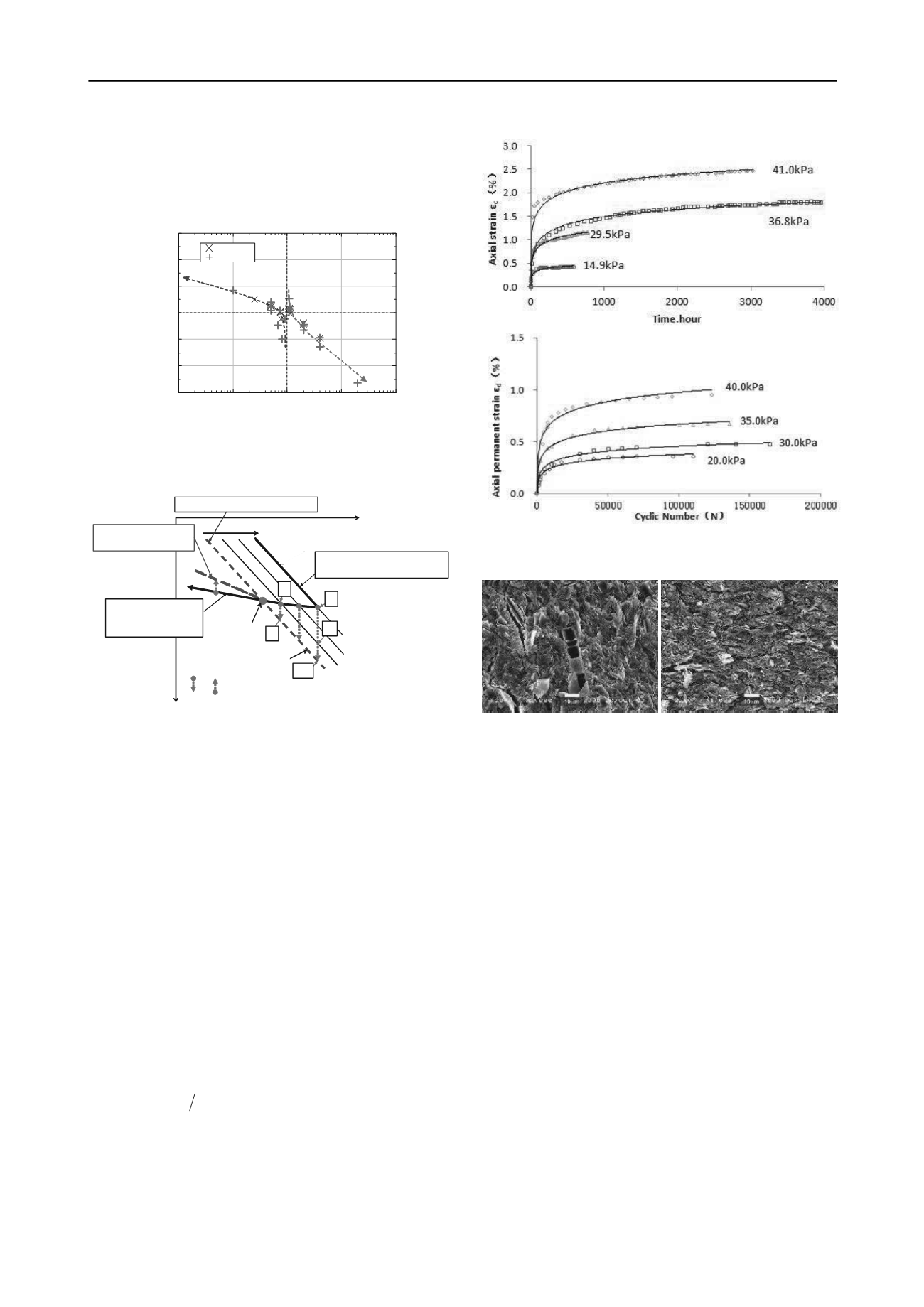
192
Proceedings of the 18
th
International Conference on Soil Mechanics and Geotechnical Engineering, Paris 2013
Proceedings of the 18
th
International Conference on Soil Mechanics and Geotechnical Engineering, Paris 2013
on the Isotach viscous properties of clays, by starting the SL
after unloading (point B, Figure 2), the zero-strain-rate relation
is reached faster. Therefore, the creep behaviour at very low
strain rates is reached in a relatively short period of time, much
shorter than if SL would start from point A.
0.01
0.1
1
10
100
-0.3
-0.2
-0.1
0.0
0.1
0.2
0.3
Creep axial strain,
a(creep)
(%)
UL
/
SL
or
RL
/
SL
FJM1008
FJM1016
Figure 1.
a(creep)
Δ
-
SL UL
/
or
SL RL
/
relations, for two
tests on reconstituted Fujinomori soft clay (Kawabe and Tatsuoka 2013)
0
Faster
Measured -log relation
No creep
or : positive or negative creep
log
Reference relation for ‘
loading
’
Reference relation for
‘
first unloading
’
Primary loading at a constant
positive total strain rate
First unloading at a
constantnegative
total strain rate
0
ir
a
B
A
C
B’
C’
Figure 2 Illustration of
a
a
log
and creep in Isotach theory
(Kawabe and Tatsuoka 2013)
In a similar desire to reduce the time for creep investigation
of fine soils, Yangsheng et al. (2013) propose a new testing
procedure based on the application of dynamic triaxial cycles of
frequencies about 5 kHz. The similarity between the measured
creep strain evolution and the permanent strains-number of
cycles relation in dynamic cyclic tests (Figure 3) is used by the
authors for the prediction of the creep strains. The analysis of
the microstructure of the clay samples issued from both creep
and cyclic loading by the scanning electron microscope shows
close resemblances. In a different approach, but somewhat
related study by Noda and Xu (2013), a numerical finite
element analysis (GEOASIA) of the behaviour of remoulded
clay under sustained small cyclic amplitudes followed by creep
under undrained conditions reveals that the mechanism of
swelling is localised and taking place on the shear bands due to
the pore water migration effects.
Re-evaluation of surcharging technique to reduce the
secondary compression effects on soft organic clay soils is
explored by Feng (2013) by conducting one-dimensional
laboratory compression tests on samples with different effective
surcharge ratios,
R’
s
, where
(1)
and
s
is the effective stress achieved at the end of
surcharging and
f
is the permanent final effective stress. The
results show that for small effective surcharge ratios, the
magnitude of secondary compression still remains excessive
while for the technique to be effective, higher values of
R’
s
are
recommended.
Figure 3 Top: drained creep strains; bottom: dynamic triaxial strain
response on remoulded clay, after Yangsheng et al. (2013).
(a) The Osaka Bay clay
(b) The Pisa clay
Figure 4. Microstructure of clays observed by SEM (Watabe et al.
2013).
Long-term consolidation laboratory tests on two undisturbed
clay soils Osaka Bay (flaky particles, typically smectite, with
large number of microfossils, Figure 4a) and Pisa (platy
particles, typically illite, with a small number of microfossils,
Figure 4b), were conducted and the results reported by Watabe
et al. (2013). The interpretation of the tests was also based on
the isotach concept (
Š
uklje 1957) and the relations proposed by
Leroueil et al. (1985). While Osaka Bay clay shows high strain
rate dependency well approximated by a curve model in line
with the response of a wide range of natural clay soils, the Pisa
clay revealed particularly smaller strain rate dependency. The
origin of this different response appears to be linked to the
presence of illite particles in Pisa clay.
The effect of a wide range of strain rates from 0.333 to
60,000 %/hr on the strength and stiffness of reconstituted kaolin
clay is investigated in triaxial testing conditions by Robinson
and Brown (2013). The strain level and drained conditions are
also considered. The influence of the rate effects on the peak
shear strength is presented in Figure 5 where the reference data
refers to a shear strain rate of 100 %/hr and V is the normalised
dimensionless velocity as previously defined by Randolph and
Hope (2004). While the experimental results fit well the rate
effects equation (Randolph and Hope 2004), the rate effect per
log cycle (tenfold) of the shear strength increase is about 22%,
higher than detected in various previous studies (about 10%).
The applied strain rate was also found to have a significant
impact on the small strain response, with the elastic shear strain
threshold,
γ
EL
, increasing with strain rate and shear stiffness,
G
0
,
appearing to reduce with strain rate (Figure 5).
f
f
s
s
R


